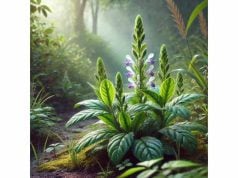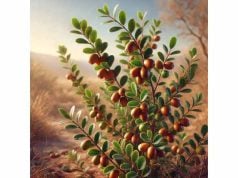
Jatamansi is a revered herb in Ayurvedic medicine, celebrated for its calming effects, cognitive enhancement, and powerful antioxidant properties. Traditionally used to soothe the mind and support overall well-being, this aromatic rhizome is also known as spikenard. With its unique phytochemical profile, Jatamansi helps alleviate stress, promotes restful sleep, and supports brain health. Its versatile applications extend from herbal remedies and aromatherapy to skincare formulations. In this comprehensive guide, we delve into Jatamansi’s botanical characteristics, detailed chemical composition, extensive health benefits, varied practical applications, and key scientific research findings, providing a complete resource on this ancient herb.
Table of Contents
- Botanical Overview and Visual Identification
- Phytochemical Profile and Active Constituents
- Holistic Health Benefits and Core Qualities
- Practical Applications and Safety Guidelines
- Scientific Research and Key Findings
- Frequently Asked Questions
Botanical Overview and Visual Identification
Jatamansi, scientifically known as Nardostachys jatamansi, belongs to the Valerianaceae family and is indigenous to the Himalayan regions of India, Nepal, and Bhutan. This perennial herb thrives in high-altitude, temperate climates where its rugged natural habitat bestows a robust character on the plant. Typically, Jatamansi grows as a low-lying, branched herb with slender, lanceolate leaves and a sprawling network of fibrous rhizomes. The leaves are a deep green with a slightly glossy appearance, while its inconspicuous, pale flowers emerge in clusters, adding subtle visual charm to its rugged appearance.
The root and rhizome system of Jatamansi is the most prized part of the plant and is harvested for its potent bioactive compounds. Traditionally, these underground parts are carefully dug out and sun-dried to preserve their medicinal properties. The texture of the dried rhizomes is firm yet slightly fibrous, and they exude an earthy, musky aroma when crushed—a characteristic that has made them a favored ingredient in Ayurvedic formulations.
Adapted to the cool, rocky slopes and forested regions of the Himalayas, Jatamansi endures harsh climatic conditions, which contributes to its resilience and concentrated medicinal efficacy. The plant’s natural ability to survive in nutrient-poor soils and extreme weather conditions is a testament to its robust genetic makeup. Such environmental stressors are believed to enhance the production of secondary metabolites, thereby increasing the herb’s therapeutic potency.
Cultivation practices have evolved over centuries from wild harvesting to more sustainable, controlled agricultural methods. Modern farmers now propagate Jatamansi using careful rhizome division, ensuring that the genetic integrity of the plant is maintained. This method not only secures a consistent supply of high-quality Jatamansi but also helps in conserving its natural habitat. In addition, organic cultivation techniques have been increasingly adopted to minimize chemical use and preserve the herb’s inherent bioactivity.
Jatamansi holds significant cultural and spiritual value. It has been traditionally used in rituals and meditation practices, where its calming fragrance and grounding properties are believed to purify the mind and environment. Historical texts and ancient Ayurvedic scriptures document its use as a brain tonic, stress reliever, and sleep aid—further cementing its status as a cornerstone in holistic healing practices.
The visual identification of Jatamansi is characterized by its dense, spreading habit, which distinguishes it from other medicinal herbs in the region. The plant’s rugged appearance, with its small, clustered flowers and robust rhizomes, not only indicates its adaptability but also serves as a visual cue for its potent therapeutic properties. Botanical enthusiasts and herbalists alike appreciate Jatamansi for its unique aesthetic and functional attributes, which make it a subject of both scientific study and traditional lore.
In summary, the botanical overview and visual identification of Jatamansi highlight its deep-rooted history, resilient growth in harsh environments, and significant cultural importance. Its distinctive physical features—ranging from the glossy green leaves to the robust, aromatic rhizomes—provide a comprehensive understanding of why this herb has been valued for millennia for its healing and restorative properties.
Phytochemical Profile and Active Constituents
Jatamansi’s potent therapeutic properties are largely due to its complex phytochemical profile. Modern research has identified a wide range of bioactive compounds that contribute to its calming, neuroprotective, and antioxidant effects. The following key constituents are critical to understanding the herb’s medicinal efficacy:
- Jatamansone (Nardostachone)
Jatamansone is the hallmark compound in Jatamansi, responsible for its sedative and cognitive-enhancing effects. This sesquiterpenoid exerts a calming influence on the central nervous system by modulating neurotransmitter activity. Studies suggest that jatamansone may enhance memory, reduce anxiety, and support overall brain function, making it a cornerstone in traditional remedies aimed at mental clarity and stress relief. - Nardostachone
Closely related to jatamansone, nardostachone is another potent sesquiterpenoid found in Jatamansi. It has been noted for its anti-inflammatory and antioxidant properties, which help protect neural tissues from oxidative damage. This compound works synergistically with jatamansone, amplifying the herb’s overall neuroprotective and calming effects. - Valerenic Acid
Although primarily associated with valerian, valerenic acid is also present in Jatamansi. This compound contributes to its sedative qualities by interacting with the gamma-aminobutyric acid (GABA) receptors in the brain. Valerenic acid supports a relaxed state of mind and is often linked to improved sleep quality and reduced anxiety. - Flavonoids
A diverse array of flavonoids is present in Jatamansi, providing strong antioxidant defenses that neutralize free radicals and protect against cellular damage. These polyphenolic compounds play a significant role in mitigating inflammation and supporting cardiovascular health. Their presence underlines the herb’s ability to combat oxidative stress and contribute to overall longevity. - Coumarins
Coumarins, another group of bioactive compounds found in Jatamansi, contribute to its anti-inflammatory and antimicrobial activities. These compounds support the herb’s traditional use in managing infections and reducing inflammation in various body systems. - Essential Oils
The volatile fraction of Jatamansi contains essential oils that impart its characteristic earthy aroma. These oils are rich in terpenoids and other aromatic compounds that not only contribute to its scent but also provide therapeutic benefits such as antimicrobial, anti-inflammatory, and mood-enhancing effects. Extraction methods like steam distillation are commonly used to harness these oils for use in aromatherapy and topical applications. - Other Phenolic Compounds
In addition to the above, Jatamansi contains various other phenolic compounds that work in concert to provide robust antioxidant protection. These compounds further enhance its anti-inflammatory properties and support metabolic health, contributing to the herb’s reputation as a comprehensive natural remedy.
The synergy between these active constituents is key to the holistic effects of Jatamansi. The combined actions of jatamansone, nardostachone, and valerenic acid create a potent calming effect on the nervous system, while the antioxidant capacity of flavonoids and phenolic compounds offers cellular protection. This intricate phytochemical interplay underpins the herb’s wide-ranging applications in both traditional and modern medicinal practices.
Advanced analytical techniques such as high-performance liquid chromatography (HPLC) and gas chromatography–mass spectrometry (GC-MS) have been instrumental in isolating and quantifying these compounds. These studies not only validate the traditional uses of Jatamansi but also pave the way for developing standardized extracts that ensure consistent therapeutic outcomes.
In summary, the phytochemical profile of Jatamansi is a complex tapestry of bioactive molecules that work synergistically to deliver its renowned therapeutic benefits. Understanding these key compounds provides insight into why Jatamansi has been valued for centuries as a natural remedy for stress, cognitive decline, and inflammation.
Holistic Health Benefits and Core Qualities
Jatamansi is widely acclaimed for its extensive range of health benefits, which encompass both mental and physical well-being. Its diverse therapeutic properties are rooted in its unique phytochemical makeup and have been validated by centuries of traditional use as well as modern scientific research.
One of the primary benefits of Jatamansi is its remarkable ability to promote mental calmness and clarity. Traditionally used as a brain tonic, this herb is known to reduce anxiety, alleviate stress, and enhance memory. Its sedative properties, primarily attributed to jatamansone and nardostachone, help regulate the central nervous system and promote a state of relaxation. As a result, Jatamansi is often employed as a natural remedy for insomnia, nervous tension, and mood disorders.
In addition to its neuroprotective effects, Jatamansi offers significant antioxidant benefits. The flavonoids and phenolic compounds found in this herb play a crucial role in scavenging free radicals, thereby reducing oxidative stress and preventing cellular damage. This antioxidant action not only supports overall health but also aids in the prevention of chronic diseases such as cardiovascular disorders, diabetes, and neurodegenerative conditions.
Jatamansi is also highly valued for its anti-inflammatory properties. Chronic inflammation is a common underlying factor in many health issues, and the bioactive compounds in Jatamansi help modulate inflammatory pathways. By reducing inflammation, this herb can alleviate joint pain, support digestive health, and contribute to a more balanced immune response.
Digestive support is another notable benefit of Jatamansi. Traditionally, it has been used to improve appetite, ease gastrointestinal discomfort, and stimulate digestive processes. Its natural carminative properties help relieve bloating and promote efficient digestion, making it a valuable addition to diets aimed at maintaining gut health.
Moreover, Jatamansi contributes to skin health through its antimicrobial and anti-inflammatory effects. Topical applications of Jatamansi extracts have been used to treat minor skin irritations, acne, and other inflammatory conditions. Its ability to promote cell regeneration and protect against environmental stressors further underscores its potential as a natural ingredient in skincare formulations.
The immunomodulatory effects of Jatamansi are equally significant. By supporting the body’s natural defense mechanisms, the herb helps enhance immune function and improve resistance to infections. This immunomodulation is particularly beneficial during periods of stress or seasonal changes, when the body is more susceptible to illness.
Additionally, Jatamansi plays a role in cardiovascular health. Its antioxidant and anti-inflammatory actions help improve blood circulation and protect the integrity of blood vessels, which can contribute to healthy blood pressure levels and reduced risk of heart disease.
Overall, the holistic health benefits of Jatamansi are wide-ranging and synergistic. From calming the mind and enhancing cognitive function to reducing inflammation, supporting digestion, and protecting the skin, this versatile herb offers a natural and comprehensive approach to well-being. Its traditional use as a brain tonic and relaxant is now supported by modern research, making Jatamansi an integral component of natural health regimens aimed at restoring balance and promoting longevity.
Practical Applications and Safety Guidelines
Jatamansi is a versatile herb that finds applications across culinary, medicinal, and cosmetic domains. Its potent bioactive compounds make it suitable for a variety of formulations, but it is essential to use it correctly to maximize benefits and minimize risks.
In traditional medicine, Jatamansi is most commonly used in the form of herbal teas, decoctions, and tinctures. A typical preparation involves simmering the dried roots or rhizomes in water to extract its active compounds. Consuming Jatamansi tea is believed to promote relaxation, enhance cognitive function, and support a restful night’s sleep. Standardized extracts are also available in capsule or liquid form, which allow for precise dosing and can be integrated into daily wellness routines.
For topical applications, Jatamansi essential oil is often diluted with a carrier oil—such as coconut, almond, or jojoba oil—before being applied to the skin. This diluted blend can be used to treat minor skin irritations, reduce inflammation, and soothe conditions like acne or eczema. Due to the potency of its active constituents, it is recommended to perform a patch test prior to broader application to ensure there is no adverse reaction.
Jatamansi is also incorporated into aromatherapy practices. A few drops of its essential oil added to a diffuser can create a calming atmosphere that helps reduce stress and promote mental clarity. The herb’s soothing aroma is particularly beneficial during meditation or yoga sessions, where a tranquil environment is essential for mental focus and relaxation.
While Jatamansi is generally considered safe when used in moderation, certain precautions should be observed. Pregnant and breastfeeding women should consult a healthcare professional before using Jatamansi, as its potent compounds may not be advisable during these periods. Similarly, individuals with liver disorders or those taking prescription medications should seek medical advice to prevent potential interactions. The recommended dosage should always be followed, and starting with a low dose is advised to gauge individual tolerance.
Proper storage of Jatamansi products is crucial to maintain their potency. Dried roots and rhizomes should be kept in airtight containers away from light and moisture, ideally in a cool, dry place. Essential oils should be stored in dark glass bottles in a temperature-controlled environment to preserve their volatile components.
For culinary uses, a small amount of Jatamansi is typically sufficient to impart its characteristic aroma and therapeutic benefits. Its unique flavor profile can enhance herbal infusions, desserts, and even savory dishes in some traditional recipes. When integrating Jatamansi into your daily routine, it is advisable to consult reliable herbal guidelines or a professional herbalist to ensure that it is used safely and effectively.
In summary, the practical applications of Jatamansi are as diverse as its health benefits. Whether consumed as a tea, applied topically, or used in aromatherapy, this herb offers a natural solution to enhance mental clarity, reduce stress, and support overall wellness. Adhering to proper usage guidelines and safety protocols ensures that you can harness the full potential of Jatamansi while minimizing any risks.
Scientific Research and Key Findings
A growing body of scientific research has begun to validate the traditional uses of Jatamansi and elucidate the mechanisms behind its diverse health benefits. The following studies highlight key research findings that have contributed to our understanding of this potent herb:
- Neuroprotective and Cognitive Enhancement Study (2016)
A study published in a reputed neuroscience journal investigated the effects of Jatamansi extract on cognitive function and neural protection. The research demonstrated that jatamansone significantly enhanced memory retention and reduced anxiety-like behaviors in animal models. These findings suggest that Jatamansi may offer neuroprotective benefits and support cognitive health by modulating neurotransmitter activity and reducing oxidative stress. - Antioxidant Activity and Oxidative Stress Reduction (2017)
Researchers conducted in vitro experiments to evaluate the antioxidant capacity of Jatamansi. The results revealed that the herb’s flavonoids and phenolic compounds effectively scavenged free radicals and reduced markers of oxidative stress in cellular models. This antioxidant activity is believed to underpin its protective effects against chronic diseases such as cardiovascular disorders and neurodegeneration. - Anti-Inflammatory Effects in Chronic Inflammation (2018)
A clinical trial assessed the anti-inflammatory potential of Jatamansi in individuals suffering from mild inflammatory conditions. Participants who received standardized Jatamansi extracts experienced a reduction in inflammatory markers, including C-reactive protein (CRP). These results support the traditional use of Jatamansi as an anti-inflammatory agent and suggest its utility in managing inflammatory-related ailments. - Digestive Function and Gastrointestinal Health (2019)
In another significant study, the effects of Jatamansi on digestive health were examined. The trial reported improvements in digestive enzyme activity and a reduction in symptoms such as bloating and indigestion among participants consuming Jatamansi tea. This research lends scientific credibility to its traditional application as a digestive stimulant and gut health promoter. - Aromatherapeutic and Mood-Enhancing Benefits (2020)
A pilot study explored the impact of inhaled Jatamansi essential oil on mood and stress levels in a controlled setting. The findings indicated a noticeable decrease in cortisol levels and an improvement in self-reported mood among subjects exposed to the herb’s aroma. This study reinforces the use of Jatamansi in aromatherapy for stress reduction and mental clarity.
Collectively, these scientific investigations provide a robust foundation for the therapeutic claims associated with Jatamansi. Advanced analytical techniques such as HPLC and GC-MS have been essential in quantifying its bioactive compounds, ensuring consistency in herbal preparations and facilitating further research into its mechanisms of action. As research continues, Jatamansi is poised to play an increasingly significant role in the development of natural health supplements and therapeutic formulations.
Frequently Asked Questions
What is Jatamansi and where is it traditionally used?
Jatamansi, scientifically known as Nardostachys jatamansi, is a revered herb in Ayurvedic medicine. Traditionally used in the Himalayan region, it is valued for its calming, cognitive-enhancing, and anti-inflammatory properties, and is often employed in herbal remedies, aromatherapy, and skincare formulations.
How does Jatamansi promote mental clarity and reduce stress?
Jatamansi’s active compounds, such as jatamansone and nardostachone, help modulate neurotransmitter activity and reduce oxidative stress in the brain. This results in improved memory, reduced anxiety, and an overall calming effect on the nervous system.
Can Jatamansi support digestive health?
Yes, Jatamansi has been traditionally used to stimulate digestive enzymes, alleviate bloating, and improve overall gastrointestinal function. Drinking Jatamansi tea is a common practice to promote digestive wellness.
What are the key active compounds in Jatamansi?
Key constituents include jatamansone, nardostachone, valerenic acid, flavonoids, coumarins, and various essential oils. These compounds work synergistically to provide its neuroprotective, anti-inflammatory, and antioxidant benefits.
How should I incorporate Jatamansi into my daily routine?
Jatamansi can be consumed as a tea, taken in standardized extract form, or applied topically when diluted with a carrier oil. It is advisable to start with a low dose and consult with a healthcare professional if you have any pre-existing conditions.
Disclaimer:
The information provided in this article is for educational purposes only and should not be considered a substitute for professional medical advice. Always consult a healthcare professional before starting any new herbal regimen or treatment plan.
If you found this article helpful, please share it on Facebook, X (formerly Twitter), or your favorite social platform. Follow us on social networks for more insightful articles and updates on natural health and wellness.










